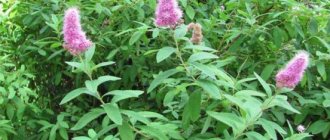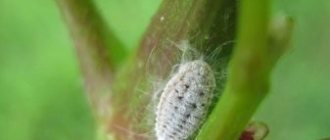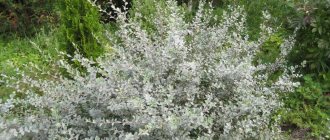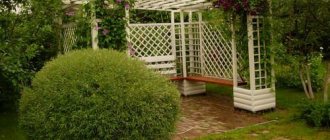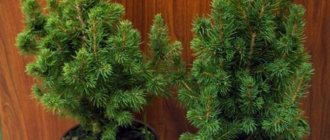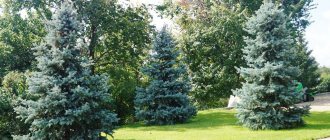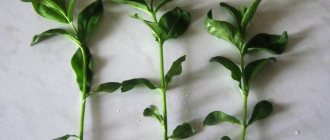Spiraea japonica Crispa plant
When I saw this gorgeous shrub with openwork carved foliage at my neighbor’s place, I couldn’t pass it by.
And the blooming of beautiful pink flowers finally convinced me that I would plant this particular type of spirea - the Japanese "Crispa" - in my garden. The numerous advantages and advantages of the plant also include unpretentiousness and the ability to withstand cold winters. Now such a plant is in my flower collection. Very elegant and compact, takes up little space. Let's talk about the main characteristics of this type of spirea, as well as the rules of planting and care.
Description of Japanese spirea "Crispa"
This plant has another name - Meadowsweet. Spiraea belongs to the Rosaceae family. A very popular plant among gardeners, since the main advantage is not only the beautiful carved foliage, but also the lush inflorescences of a bright pink hue.
Origin story
- The name spirea is translated from ancient Greek as “speira”, that is, “bend”. Indeed, the shoots of the bush are very flexible, and the leaves seem to be hand-carved by a craftsman.
- Under natural conditions, spirea can be found in the steppe and forest-steppe zones, as well as in semi-deserts. There are at least 100 species in total.
- Meadowsweet has been mentioned since the 15th century, and in the 19th it was included in V.I. Dahl’s dictionary. Today there are quite a lot of varieties grown. The unpretentiousness and undemanding nature of the plant allows it to be planted in different regions.
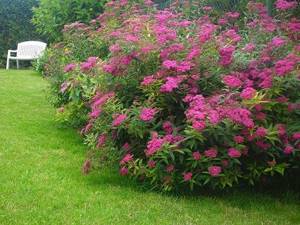
Botanical description
- Spiraea is a deciduous plant in the form of a shrub. The plant is elegant, used as ground cover. Its height is no more than 50 - 60 cm, diameter is about 1 m. Over the course of a year, the bush grows by 10 - 15 cm.
- The crown is dense, spherical, with lush foliage and bright flowering. The branches are straight, but there are also slightly curved ones, growing from the middle of the bush. At first they have a reddish tint, but over time they become gray. The shape of the bush is compact, which is convenient if the area of the plot or flower bed is small.
- The structure of the root system is shallow fibrous. You should carefully loosen and weed the soil so as not to damage the roots.
- During active flowering, the bush is covered with very beautiful inflorescences with a circumference of 5 - 6 cm, which consist of bright pink flowers 5.5 cm in circumference. The structure of the flowers is not double.
- The flowering period begins in mid-summer (second decade of July), buds appear only on last year's stems. Flowering is quite long, lasting about 1.5 - 2 months.
- The special charm and highlight of spirea is its leaves. Absolutely fantastic shape: openwork, rugged, wavy, the surface is very fragile and delicate. They are arranged alternately on the branches, elongated, up to 8 cm long. The upper part of the leaf is pointed.
- The color scheme is also very impressive - at first the foliage is reddish in color, then turns into a rich, bright green color. In autumn, the leaf blades acquire an orange-scarlet, crimson hue.

The shrub is not prone to diseases, which distinguishes it from many garden plants. However, pests sometimes pester the plant. These include spider mites, aphids, rose leaf miners and roseate leaf rollers.
This type of spirea is most often planted as a tapeworm, along borders, as an accent plant in a composition. Looks very elegant in mixborders, rock gardens, and edgings.
Varieties of Japanese spirea
'Anthony Waterer' has narrow, lanceolate, dark green leaves that turn a striking purple color in autumn. Rich pink flowers appear in midsummer.
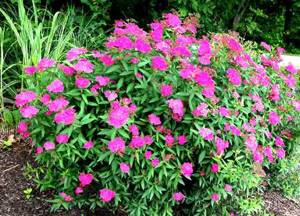
“Little Princess” is a compact, round-shaped bush just over half a meter tall. In late spring to mid-summer it is covered with numerous pink inflorescences. The green leaves turn a gorgeous shade of red in the fall.
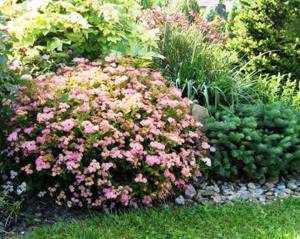
"Macrophylla" is a large shrub about 1 meter high with large rounded leaves, which amaze with their decorative effect in the autumn, acquiring all shades of red, orange and purple.
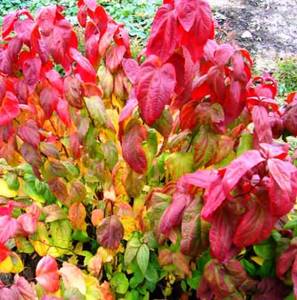
"Albiflora" is a compact bush, reaching about 60-80 cm in height, characterized by white flowering.

A miniature, round-shaped variety “Golden Carpet” is only 20-30 cm tall with creeping shoots. Attracts gardeners with its amazing lemon-colored foliage.
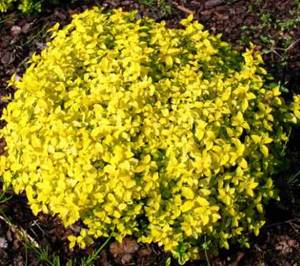
Spiraea "Golden Princess" is a low compact bush that at the age of 10 years reaches 50 cm in height and 80 cm in width. Numerous small leaves of intense golden color retain their shade throughout the growing season. In summer, the decorative value of the plant increases due to abundant flowering.
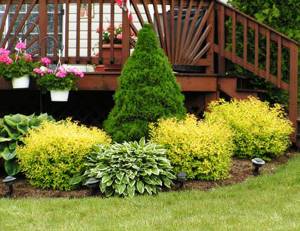
Variety “Dart's Red” is about 60 cm high. Light green lanceolate leaves, flat inflorescences of ruby-pink color adorn the round-shaped bush from June to September.
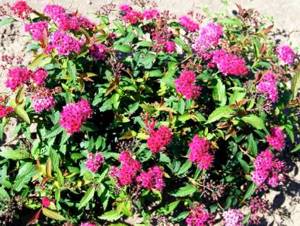
The variety "Japanese Dwarf" or "Japanese Dwarf" is a dwarf compact shrub, about 40 cm in height. The annual growth is 5 cm. During the flowering period, the bush is completely covered with large pale pink inflorescences.
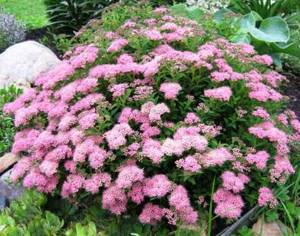
"Bullata" is an original variety, which is a low-growing bush with dark green wrinkled leaves. Its height is about 40 cm. Ideal for decorating rock gardens and alpine slides.
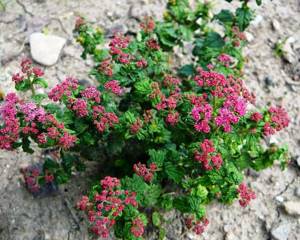
"Crispa" is a varietal form with jagged leaves and large pink inflorescences. Grows up to 60 cm. In autumn the leaves turn red-violet.
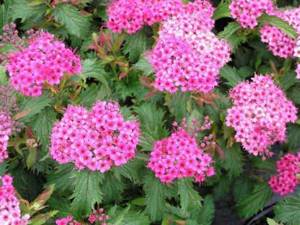
The cultivar 'Walbuma', commonly sold under the brand name 'Magic Carpet' , was developed by an English breeder and is a ground cover and spreading shrub with small bright pink inflorescences.
Its young creeping shoots and leaves are initially orange-red in color, and as they grow they acquire a lemon color that varies depending on the light. In full sun, mature leaves are golden, and in partial shade they are golden green.
The autumn color of the foliage is red-pink, plant height is 30-40 cm.
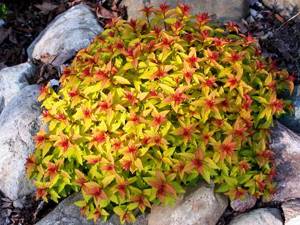
The variety “Goldflame” or “Golden Flame” received its name due to the shoots, which seem to “burn” at the tips with an intense copper color - young leaves are initially tinged with brown and red, and later become yellow-green.
Therefore, in spring this variety of Japanese spirea is one of the brightest shrubs.
Dark pink flowers appear on the current year's shoots.
The height of an adult bush is about 80 cm.
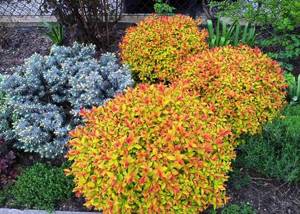
Varietal form "Goldmound" . A fabulous shrub with bright, sunny foliage, the color of which depends on the brightness of the light.
Planted in the shade, it loses its decorative color as the foliage turns green.
Easily withstands minus 30 degrees and even lower temperatures.
Flowering from May to July.
The bush has a beautiful round shape and grows up to 60 cm in height.
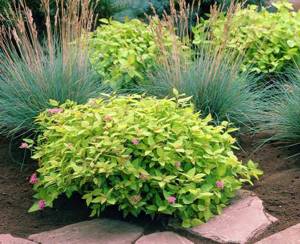
Landing Features
If the root system is closed, then it can be planted from the first months of spring until mid-autumn. If you purchased seedlings with bare roots, then plant them either in early spring or in autumn. Consider the weather in your region so that the plant has time to adapt and take root before frost sets in.
General recommendations
All plants have growing characteristics. Spiraea japonica Crispa is no exception. What do you need to know about growing first? Let's look at it in more detail.

- The best soil for the plant will be leaf or turf. You can prepare a nutritious soil mixture yourself: mix 1 share of river sand and peat and add 2 shares of soil.
- It is recommended to make a drainage layer in the planting hole. Add crushed stone, pebbles, small pieces of brick or expanded clay. The roots should receive the right amount of air, and there should be no stagnation of moisture.
- Prepare a hole one third larger in size than the volume of the root system. The seedling is buried at least 50 cm. In this case, the root collar should be located at the level of the soil surface.
- The most comfortable time for planting is the beginning of autumn - September. Plant in the morning or evening, or better in rainy or cloudy weather.
- Spiraea gets along well next to conifers. If you plant it next to thujas, junipers or spruce trees, the plant will look healthy and blooming.
Planting spirea in spring
Experienced flower growers recommend planting in spring only those varieties that bloom in summer. It is important to have time to plant the seedlings before the sap begins to flow and before the leaves begin to bloom.

- Selection of seedlings. Before purchasing, be sure to check the condition of the root system. All shoots must be healthy and intact. The branches should not have any violations of tissue integrity. If there are shoots that are dry or damaged by pests or diseases, then it is better not to purchase the plant. The branches should bend well and the buds should be in excellent condition.
- Preparatory work. Straighten the root shoots and shorten them a little. If the roots are dried out or damaged, then the branches should be trimmed a little. Before planting, it is advisable to place the dried roots in a container of water for a while so that they are saturated with moisture. Only then plant.
- Choosing a location. Choose a well-lit place for the plant, prepare the area before planting, and remove weeds. The bushes grow strongly, and the root system produces shoots. This must be taken into account when planting.
- Dig a hole and leave it for 2 - 4 days, then you can plant. After planting, do not forget to water the plant with plenty of settled water (10 - 20 l), and mulch the soil around the trunk with peat. This way the moisture will remain for a long time, and weeds will not grow next to the spirea and take away useful substances.
Planting in autumn
During this period, many types of spirea can be planted. You can also propagate the plant by dividing the bush. But then you need to be in time before the foliage begins to fall. Spiraea that are at least 3 to 4 years old are suitable for this procedure.
Spirea
When I saw this gorgeous shrub with openwork carved foliage at my neighbor’s place, I couldn’t pass it by. And the blooming of beautiful pink flowers finally convinced me that I would plant this particular type of spirea - the Japanese "Crispa" - in my garden.
The numerous advantages and advantages of the plant also include unpretentiousness and the ability to withstand cold winters. Now such a plant is in my flower collection. Very elegant and compact, takes up little space. Let's talk about the main characteristics of this type of spirea, as well as the rules of planting and care.
Description of Japanese spirea "Crispa"
This plant has another name - Meadowsweet. Spiraea belongs to the Rosaceae family. A very popular plant among gardeners, since the main advantage is not only the beautiful carved foliage, but also the lush inflorescences of a bright pink hue.
Origin story
- The name spirea is translated from ancient Greek as “speira”, that is, “bend”. Indeed, the shoots of the bush are very flexible, and the leaves seem to be hand-carved by a craftsman.
- Under natural conditions, spirea can be found in the steppe and forest-steppe zones, as well as in semi-deserts. There are at least 100 species in total.
- Meadowsweet has been mentioned since the 15th century, and in the 19th it was included in V.I. Dahl’s dictionary.
Today there are quite a lot of varieties grown. The unpretentiousness and undemanding nature of the plant allows it to be planted in different regions.
Botanical description
- Spiraea is a deciduous plant in the form of a shrub. The plant is elegant, used as ground cover. Its height is no more than 50 - 60 cm, diameter is about 1 m. Over the course of a year, the bush grows by 10 - 15 cm.
- The crown is dense, spherical, with lush foliage and bright flowering.
The branches are straight, but there are also slightly curved ones, growing from the middle of the bush. At first they have a reddish tint, but over time they become gray. The shape of the bush is compact, which is convenient if the area of the plot or flower bed is small. - The structure of the root system is shallow fibrous.
You should carefully loosen and weed the soil so as not to damage the roots. - During active flowering, the bush is covered with very beautiful inflorescences with a circumference of 5 - 6 cm, which consist of bright pink flowers 5.5 cm in circumference. The structure of the flowers is not double.
- The flowering period begins in mid-summer (second decade of July), buds appear only on last year's stems. Flowering is quite long, lasting about 1.5 - 2 months.
- The special charm and highlight of spirea is its leaves.
Absolutely fantastic shape: openwork, rugged, wavy, the surface is very fragile and delicate. They are arranged alternately on the branches, elongated, up to 8 cm long. The upper part of the leaf is pointed. - The color scheme is also very impressive - at first the foliage is reddish in color, then turns into a rich, bright green color.
In autumn, the leaf blades acquire an orange-scarlet, crimson hue.
The shrub is not prone to diseases, which distinguishes it from many garden plants. However, pests sometimes pester the plant. These include spider mites, aphids, rose leaf miners and roseate leaf rollers.
This type of spirea is most often planted as a tapeworm, along borders, as an accent plant in a composition. Looks very elegant in mixborders, rock gardens, and edgings.
Landing Features
If the root system is closed, then it can be planted from the first months of spring until mid-autumn. If you purchased seedlings with bare roots, then plant them either in early spring or in autumn. Consider the weather in your region so that the plant has time to adapt and take root before frost sets in.
General recommendations
All plants have growing characteristics. Spiraea japonica Crispa is no exception. What do you need to know about growing first? Let's look at it in more detail.
- The best soil for the plant will be leaf or turf. You can prepare a nutritious soil mixture yourself: mix 1 share of river sand and peat and add 2 shares of soil.
- It is recommended to make a drainage layer in the planting hole. Add crushed stone, pebbles, small pieces of brick or expanded clay. The roots should receive the right amount of air, and there should be no stagnation of moisture.
- Prepare a hole one third larger in size than the volume of the root system. The seedling is buried at least 50 cm. In this case, the root collar should be located at the level of the soil surface.
- The most comfortable time for planting is the beginning of autumn - September. Plant in the morning or evening, or better in rainy or cloudy weather.
- Spiraea gets along well next to conifers. If you plant it next to thujas, junipers or spruce trees, the plant will look healthy and blooming.
Planting spirea in spring
Experienced flower growers recommend planting in spring only those varieties that bloom in summer. It is important to have time to plant the seedlings before the sap begins to flow and before the leaves begin to bloom.
- Selection of seedlings. Before purchasing, be sure to check the condition of the root system. All shoots must be healthy and intact. The branches should not have any violations of tissue integrity. If there are shoots that are dry or damaged by pests or diseases, then it is better not to purchase the plant. The branches should bend well and the buds should be in excellent condition.
- Preparatory work. Straighten the root shoots and shorten them a little. If the roots are dried out or damaged, then the branches should be trimmed a little. Before planting, it is advisable to place the dried roots in a container of water for a while so that they are saturated with moisture. Only then plant.
- Choosing a location. Choose a well-lit place for the plant, prepare the area before planting, and remove weeds. The bushes grow strongly, and the root system produces shoots. This must be taken into account when planting.
- Dig a hole and leave it for 2 - 4 days, then you can plant. After planting, do not forget to water the plant with plenty of settled water (10 - 20 l), and mulch the soil around the trunk with peat. This way the moisture will remain for a long time, and weeds will not grow next to the spirea and take away useful substances.
Planting in autumn
During this period, many types of spirea can be planted. You can also propagate the plant by dividing the bush. But then you need to be in time before the foliage begins to fall. Spiraea that are at least 3 to 4 years old are suitable for this procedure.
If the bushes are even older, then you can divide them, but their root system has already grown very much, and the roots will have to be cleared of too large a lump of earth.
- The bush needs to be carefully dug up. Even if a few roots break off, it’s not a big deal, the plant won’t suffer from it.
- Then the root system is usually thoroughly washed from the old soil. If the lump is too large, you can put the seedling in a bucket of warm water for a while.
- When the soil is completely soaked, the roots are washed well under running water. You need to carefully untangle and straighten them.
- Next, use a disinfected pruner to divide the bush into parts. It turns out several parts, less often 3 - 4. Each of them should have a healthy root lobe and at least 2 - 3 strong and strong branches. The roots of spirea look like threads or cords. They need to be trimmed.
- Place a seedling in a pre-dug hole and spread the root shoots around the perimeter. Next, fill it with soil and compact it so that there are no voids. Water the planted plant.
Rules of care
The plant is unpretentious and undemanding. However, you need to follow the most general recommendations so that the bush pleases with lush foliage and bright flowers.
Is pruning necessary?
The lifespan of spirea is no more than 6 - 7 years, so pruning must be done periodically. In the spring, frozen, broken and rotten branches are removed. In total, three types of trimmings are used:
- formative;
- sanitary;
- rejuvenating.
If, immediately after the winter cold, as soon as the snow thaws, you prune and remove about 20 - 22 cm of shoots, then in July the spirea bush will delight you with abundant and long-lasting flowering. After it, remove all faded inflorescences and dry branches. Rejuvenating and formative pruning can cause a second wave of flowering of the shrub.
Conclusion
- Spiraea Japanese Crispa will decorate any corner of the garden or flower bed. Looks great as a single plant or among conifers as an accent plant. Has the highest ratings as an ornamental shrub.
- Spirea is not capricious and unpretentious in care. Prefers sunny places or partial shade. If care is appropriate, then in mid-summer you can see beautiful blooms.
- You need to water and feed according to a schedule.
The bush needs regular pruning.
Source: https://sornyakov.net/flowers/spireya-krispa.html
Rules of care
The plant is unpretentious and undemanding. However, you need to follow the most general recommendations so that the bush pleases with lush foliage and bright flowers.
Watering and fertilizing
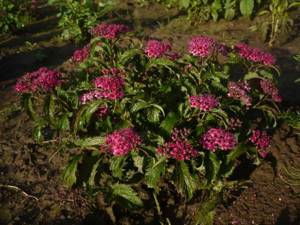
- The main requirement is that the plant does not tolerate stagnation of moisture in the soil. Therefore, if spirea grows in the shade and damp place, then a prerequisite for planting is the presence of a drainage layer.
- The bush can grow successfully in slightly acidic and slightly alkaline soils. But leaf soil is most suitable for Japanese spirea. After planting, mulch the ground around the bush with chopped bark and leaves.
- As for fertilizing, the plant can do without it. But if you want to achieve lush and especially bright flowering, you can add it in the spring, after pruning.
- You can also feed at the end of summer (August) with superphosphate. Then the shoots will develop well.
Is pruning necessary?
The lifespan of spirea is no more than 6 - 7 years, so pruning must be done periodically. In the spring, frozen, broken and rotten branches are removed. In total, three types of trimmings are used:
If, immediately after the winter cold, as soon as the snow thaws, you prune and remove about 20 - 22 cm of shoots, then in July the spirea bush will delight you with abundant and long-lasting flowering. After it, remove all faded inflorescences and dry branches. Rejuvenating and formative pruning can cause a second wave of flowering of the shrub.
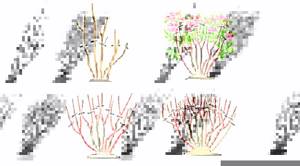
Description of Spiraea Crispus
Japanese spirea Crispa (pictured below) is a small shrub with a dense, cap-shaped crown. It is a decorative form of Japanese spirea - a perennial deciduous shrub of the Rosaceae family, growing in China, Korea and Japan.
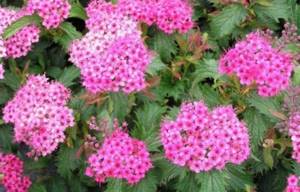
The main characteristics and description of Japanese Crispa spirea are presented in the table.
Height of an adult bush
Erect, sinewy, freely branching
Young leaves are reddish, later dark green; in autumn the color changes to scarlet or orange with a bronze tint. The leaf blade is wavy, deeply cut, ovoid
They appear on shoots after 2 years of life. Collected in lush simple umbrellas with a diameter of up to 5.5 cm, delicate mauve color
1.5-2 months (July-August)
Decorative gardening, landscape design
Description

Japanese spirea is one of the representatives of the Rosaceae family. The shrub is compact in size, deciduous, and can be grown in various regions of our country. Pay attention to the photospirea presented on our website.
An interesting feature of the color of spirea foliage is that only when they bloom in the spring, they are brown, then by summer they turn green, and closer to autumn the foliage becomes red. Many landscape designers use this unique feature of spirea, giving the site a magnificent look.
Spiraea flowers have a pinkish-red hue, are small, but collected in rather lush and multiple inflorescences. The diameter of one inflorescence can be either 5 or 30 centimeters, depending on the variety. In addition, this plant has a very long flowering period: from the end of June until the fall.
All varieties of spirea are divided into:
The first ones begin to bloom from mid-late May, and the second ones (there are more of them) - from the end of June. Japanese spirea is a summer-flowering variety.
Varieties
Little princesses

A compact shrub that grows 50-60 cm in height. The pink color of the inflorescences-corythes contrasts perfectly with the dark green dense foliage (see photo).
Goldflame
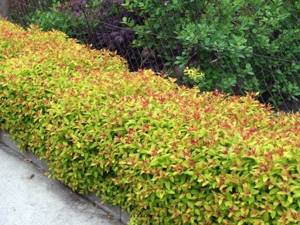
A variety characterized by a particularly noticeable change in foliage color. The flowers are small, pink, and look very decorative against the background of beautiful leaves.
Crispa
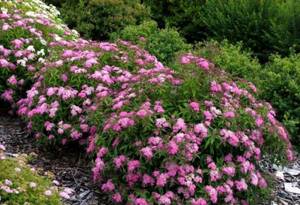
A low shrub, does not grow higher than half a meter. The flowers are very delicate, light pink, collected in graceful umbrella inflorescences. Spiraea Crispa is valued for its long-term flowering - the decorative period lasts about two months.
Macrophila
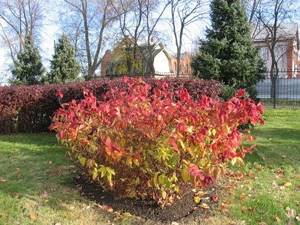
It is distinguished by extremely decorative foliage that changes color. So, in the spring, the leaves of Macrophila have a purple tint, in the summer - green, and in the fall the foliage becomes golden and orange.
Golden princesses

This Spiraea reaches a meter in height and is distinguished by reddish-pink flowers and yellow foliage.
A variety such as Shirobana is also often planted. The variety boasts a compact bush and simultaneous flowering of both pink and white flowers on one plant.
In landscape design, Japanese spirea is valued for its exceptional decorative properties. Various varieties of it are used to create hedges and to decorate flower arrangements and alpine slides.
Spiraea japonica Crispa in landscape design
Thanks to its compact size, dense rounded crown and long flowering, Japanese Crispa spirea has found wide use in landscape design. It is planted both in single and group plantings. Often a flowering bush is used as a color accent, the central element of a flower bed, or a single plant when planted in containers or flowerpots.
In group plantings, Crispa spirea is effective in mixboards, mixed plantings, as an element of the design of paths and alleys, as one of the steps of a multi-level or low separate hedge.
General characteristics of the plant
Spiraea (or in Latin Spiraea) is a bright representative of the Rosaceae family. This is a beautifully flowering deciduous shrub that has easily adapted to our climate and is grown in many regions of Russia.
The genus Spiraea includes at least 90 plant species. About half of the wild species have been introduced into garden culture. Thanks to the efforts of breeders, new varieties of spirea appear regularly.
The most popular is the Japanese spirea (or in Latin Spiraea japonica), which came to us from Japan and China. It is not whimsical and is very loved by gardeners for its decorative foliage and luxurious, abundant and long-lasting flowering.
To learn how to properly plant and grow Schisandra chinensis, read the article.
You can also learn a lot of useful information about delphinium, its planting and care.
The elliptical or ovoid leaves of the plant have an interesting feature. In the spring, starting to bloom, they turn reddish-brownish, turn green in the summer, and by autumn they again acquire a reddish color. Using this effect, breeders have created many varieties with unusual foliage that does not change throughout the season.
The pink-red flowers of the plant are collected in lush thyroid inflorescences with a diameter of 5 to 30 cm, depending on the variety. Among representatives of its genus, Japanese spirea is the record holder for the duration of flowering.
In mid- or late June it becomes covered with fragrant caps of flowers and continues to bloom until autumn. During flowering, Japanese spirea is a very spectacular sight.
According to the flowering period, all cultivated species of the genus Spiraea are divided into spring-flowering (from the end of May) and summer-blooming (from the end of June). Japanese spirea is a summer flowering plant.
For more information about Japanese spirea, watch the video:
Planting and caring for Crispa spirea
It is best to plant this ornamental shrub in open ground in spring or autumn, and if the seedling has a closed root system, then in summer. Planting and caring for the Japanese Crispa spirea is simple and will not cause any difficulties even for beginners.
Preparation of planting material and site
It is advisable to purchase planting material in specialized stores or nurseries. Sometimes seedlings of this plant can be found there under the name Spiraea curly Crispa. They are usually sold in special planting containers filled with soil. Often there are seedlings with roots coated with clay mortar. If the root system is open, it must be inspected. A spirea seedling suitable for planting must have a significant number of thin, long roots - lobes, as well as healthy, strong tap roots without signs of rot.
Spiraea Japanese Crispa grows well in open, well-lit areas; it can also be planted in light partial shade. The plant is unpretentious to soil composition and grows on both slightly acidic and slightly alkaline soils. However, it is desirable that the acidity be close to neutral, so gardeners often make planting holes of increased size, filling them after planting with pre-prepared soil with an optimal pH level.
The planting hole is made in advance, usually 1/3 larger than the size of the root system. A layer of drainage made from fragments of brick or crushed stone is laid on its bottom.
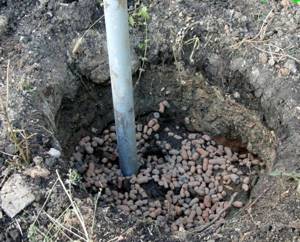
Planting Spiraea Crispus
It is best to plant Japanese spirea Crispa in open ground on a rainy, cloudy day. Before planting, the container with the seedling is spilled generously with water. This will make it easier to remove. The plant is planted in a planting hole along with a lump of earth. Exposed roots must first be straightened out. Then the hole is covered with earth so that the root collar of the bush is flush with the surface of the earth. Then the Crispa spirea seedlings are cut by about 1/3, after which abundant watering is carried out, and the root zone is mulched with peat.
Spiraea Japanese Crispa - convenient in everything! – Vegetable garden, garden, balcony – MirTesen media platform
Not every flower lover can afford a large plot of land, so miniature, maximally decorative shrubs are gaining increasing popularity for gardeners with low-maintenance gardens.
The most popular in this regard now are Japanese spirea, which have won the hearts of many gardeners with their colorful foliage, but varieties with green leaves, especially such carved ones as those of the Crispa spirea variety, can be no less attractive.
Description of the variety
Japanese spirea belongs to the ornamental deciduous shrubs of the Rosaceae genus and is valued for:
• Lush, long-lasting flowering;
• Permanent decorative effect due to beautiful foliage;
• Round, small bush shape.
The Crispa variety differs from other varieties of Japanese spirea:
• Due to its small size - the bush reaches a height of only 0.5 -0.6 m with a fairly dense crown;
• The foliage of the variety has a special delicacy, unlike other varieties, due to the twisted leaf blade and a more frequent arrangement of denticles along the edge of the leaf;
• Young shoots of the plant have reddish-burgundy matte foliage, which later acquires a dark green tint;
• Purple-pink flowers collected in a very dense corymb.
Such a bush will look especially good as a tapeworm or an accent in a composition.
Planting and care
Japanese spirea with a closed root system is planted from early spring to autumn; for plants with an open root system, it is better to plant in early spring or autumn. In order for the Japanese spirea bush to take root well, it is planted as follows:
• Before planting, the bush must be watered; if the lump is too dry, the plant in the pot is immersed in water for a while;
• Then the plant is removed from the pot, and overgrown roots are cut off;
• Damaged parts of the root system are also removed;
• When planting, the roots are straightened in the planting hole;
• The soil from the tips of the roots is mixed with planting soil and the resulting mixture is covered with the bare roots of the plant;
• It is also better to shorten the branches by 1/3 of the height.
Japanese spirea is not too demanding to care for, however, it does not tolerate stagnant water and in areas with high groundwater levels it must be drained. Spiraea Crispa also withstands slightly alkaline and slightly acidic soils, adapting to any of their compositions .
The best growth results will be for spirea planted in the ground with the addition of leaf humus and mulched bark or leaves.
The plant does not require fertilizing and can delight gardeners with its appearance without much effort. However, if you need very lush flowering, then the bushes are fed in the spring, after pruning. It is also useful to feed the plant with superphosphate in August to ripen the branches.
Japanese spirea propagates by dividing the bush, layering or cuttings.
Spirea pruning
Some branches of the bush may freeze in the spring and also dry out due to their short life. On average, a spirea branch can live 6 - 7 years, so three types of pruning are recommended for spirea:
• Formative;
• Rejuvenating;
• Cosmetic.
In early spring, the plant is shortened to a height of 20 cm, removing shrunken old branches and branches damaged by frost. With this pruning, the spirea will bloom in mid-summer.
The spirea can be pruned a second time after flowering. During this period, remove dried flower stalks and branches that violate the shape of the bush, if any.
But there is another pruning option. Since spirea bushes bloom on overwintered branches, dense bushes of regular shape are not pruned in the spring, but only branches damaged in winter are removed.
This spirea will bloom earlier - in early summer. After flowering, just as in the first case, the inflorescences are cut off and at the same time, rejuvenating and formative pruning is performed.
In warm years, with such pruning in the fall, you can get a second, but less lush flowering.
Use in landscape design
Spiraea japonica Crispa is a plant of all seasons. During spring, summer and autumn, the shrub appears in all its beauty and every part of the plant is decorative. In the southern regions, its rounded reddish buds will decorate the fourth season. In addition, you don’t have to cut off the faded shoots if you like the shields of the seed pods and from mid-summer they don’t greatly spoil the appearance of the garden.
Japanese spirea Crispa can be used for various garden compositions:
• In perennial flower beds, ridges and mixborders;
• In annual flower beds;
• In tree and shrub deciduous compositions;
• In tree-shrub coniferous (mixed) compositions;
• As a border;
• As one of the levels of a multi-stage hedge;
• In rockeries and large alpine slides;
• In containers;
• In separate plantings for the overall appearance of the garden.
All these types of plantings are available for spirea due to the appearance and shape of the bush, as well as its low growth. The latter quality is especially important for plantings with coniferous plants, because often autumn foliage falling on coniferous plants spoils the needles. In addition, the shrub goes well with any color of pine needles.
When planted in a container, the plant requires more careful care, namely fertilizing, constant watering, and winter maintenance in a special room. Pots can also be buried and covered in the garden for the winter, but you need to remember about the drainage necessary for the root system of the plant.
Source
Source: https://ogorod.mirtesen.ru/blog/43247445481/Spireya-yaponskaya-krispa-%E2%80%93-udobnaya-vo-vsem!
Reproduction
Like most shrubs, Japanese spirea Crispa can be propagated by seed and vegetative methods. The seeds are collected 1.5-2 months after flowering so that they are fully ripe. The collected material is stratified, kept for several months at sub-zero temperatures. To do this, you can use any container that can be stored in the refrigerator or simply buried in the snow. In early spring, seeds are planted under film, and after 2-3 months the young plants are transplanted into a greenhouse for growing.
However, the seed method does not guarantee that a varietal plant will grow from a seed. When propagated by seeds, only species characteristics are preserved, while varietal characteristics may be lost. Therefore, Crispa spirea is often propagated by the following vegetative methods:
- cuttings;
- dividing the bush;
- layering from the mother bush.
Cuttings are an easy way to propagate spirea while maintaining all varietal characteristics. Cuttings are cut in September from the current year's shoots so that each has 5 leaves. The lower ones are removed, the top 2 leaves are cut in half. The finished planting material is placed with the lower cut in Epin's solution for 12 hours, then treated with Kornevin powder and planted in a container filled with damp sand. The cuttings are buried 2 cm at an angle of 45°. Then the container is covered with glass or film and placed in a warm place.
From time to time, spirea cuttings are ventilated, removing the cover, and also sprayed with water, keeping the sand moist. Rooting usually occurs within 1-2 months, after which young spirea seedlings are planted in separate containers.
Dividing a bush is a simple, but rather labor-intensive way to propagate Japanese spirea Crispa. This event usually takes place in September. A spirea bush at the age of 3-5 years is completely dug up and the soil is washed away from the roots with water pressure from a hose. Then, using garden pruners, the bush is divided into several parts - the so-called divisions. Each of them should have several well-developed shoots, taproots and fibrous roots.
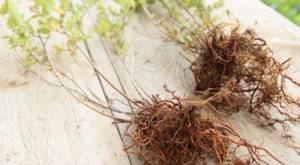
The finished cuttings are planted in planting holes in the same sequence as during normal planting of seedlings.
Layerings can be obtained by bending a long side shoot of Crispa spirea to the ground and fixing it in this position. The contact area must be covered with earth. If you regularly water this area, the allocated shoot will quickly take root and send out its own sprout. In this position, the plant is left for the winter. In early spring, the cuttings can be separated from the mother shoot, dug up along with the roots and transplanted to a permanent place.
Diseases and pests
Diseases rarely attack Spiraea Crispus. Most often this happens on old, neglected bushes that have not received any care. Lack of pruning leads to a strong thickening of the internal space; impaired air exchange provokes increased humidity. In such conditions, fungi multiply rapidly, especially if the summer is cool and rainy. When signs of the disease appear, the affected shoots must be cut out and burned. You can stop the spread of the fungus by spraying the bush with a solution of any fungicide, for example, copper sulfate.
The most common pests that appear on Spira Crispus are aphids, leaf rollers and spider mites. You can get rid of them by spraying with special means. If detected early, it is sometimes possible to avoid this by simply tearing off the leaves along with the insects.
Japanese spirea "Crispa": description, planting and care

Ornamental plants are an integral part of every personal plot, city parks and alleys. They are the ones who make our life bright and colorful. The long work of breeders has led to the emergence of a huge number of different varieties of flowers, which differ in shape, size, flowering period and method of care. To independently create green compositions, landscape architecture experts recommend using perennial, unpretentious varieties, the care of which will not cause difficulties. Spiraea “Crispa” belongs to this category. This plant has a spectacular appearance and brightly colored inflorescences, which will help decorate any green composition.
Peculiarities
Japanese spirea “Crispa” is a low shrub that has a dense crown in the shape of a ball and is a decorative type of Japanese spirea. This variety is a perennial deciduous plant and belongs to the Rosaceae family. The birthplace of the flower is the territory of China, Korea and Japan. Descriptions of this plant can be found in all collections of botany.
The height of an adult plant reaches 70 cm, and the diameter of the crown is 80 cm. The branches of this plant are straight, freely branching, elastic, with a large number of veins. The leaf blade has an oval shape with wavy edges. A distinctive feature of the leaves is their color change depending on the time of year.
In early spring, the leaves have a reddish tint, in summer they are dark green, but in autumn the bushes are covered with scarlet and orange leaves with a bronze coating.
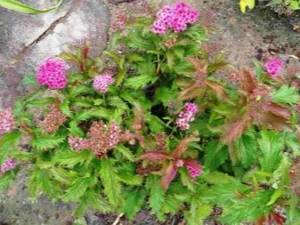
The flowers, which are painted in a soft pink hue, are collected in simple inflorescences and appear only on the shoots of the second year of life. The maximum diameter of the inflorescence is 6 cm. Flowering begins in mid-summer and continues for 2 months.
Advantages:
- spectacular appearance;
- unpretentiousness;
- long flowering period;
- ease of care.

Decorative varieties and their features
Thanks to the achievements of breeders, more than fifty varieties of Japanese spirea are known today. At the same time, planting and care for each of them do not differ significantly. And they are all charming in their own way. Only some of the most popular varieties are discussed below.
- "Goldflame" is a plant with small pink (sometimes with a reddish tint) flowers and changing foliage. The leaves are orange in the spring, then turn yellow, then green with a hint of yellow, and finally turn orange with a hint of copper in the fall.
- 'Little Princess' is a small shrub, 60 centimeters or less in height, with dark green leaves. The flowers, the diameter of which can reach up to four centimeters, can be either red or pink.
- "Golden Princess" is a variety of Japanese spirea up to 100 centimeters high. It has red-pink inflorescences and yellow foliage.
- "Shirobana" is a bush no more than 60 centimeters high with a wide crown, sometimes reaching 1.2 meters in diameter. Flowers (white or pink) appear at the very end of July.
- "Macrophylla" is an interesting plant with wrinkled leaves of purple and red hues and umbrella-shaped pale pink inflorescences.
- “Crispa” is a shrub no more than 50 centimeters high with small pink flowers of a lilac hue, collected in the form of umbrella inflorescences. It blooms for approximately two months, starting in mid-summer.
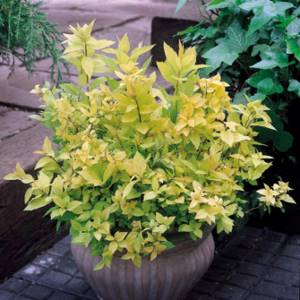
Japanese spirea in a flowerpot on the garden stairs

Japanese spirea in vertical gardening at home
How to plant?
Proper selection of a place for a plant and planting taking into account all requirements is the key to obtaining a beautiful and healthy plant. Despite the unpretentiousness of this flower, experienced gardeners recommend paying special attention to its planting. The most favorable time for this event is the beginning of spring or mid-autumn, but if the purchased planting material has a closed root system, then it can be planted throughout the entire growing season.
The plant feels most comfortable in well-lit areas that are protected from strong currents of cold air. Experts allow planting in areas with slight shading, but constant exposure to shade can negatively affect the brightness of the inflorescences and the density of the crown. The unpretentious flower feels good in all types of soil, but it is still better if the acidity of the soil is close to neutral. The plant does not do well in wetlands where groundwater is close to the surface.
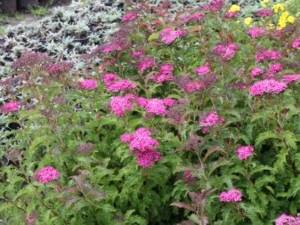
Before you start planting seedlings, you need to choose them correctly. Experienced gardeners recommend purchasing planting material from specialized nurseries that sell only high-quality products. Most seedlings are sold in small containers. Some manufacturers sell flowers whose root system is covered with a thick layer of clay, which prevents it from drying out. Experts recommend avoiding purchasing bare-rooted plants, which may become unusable and dry out during transportation.
Signs of healthy roots are the presence of long roots without mechanical damage and signs of disease.
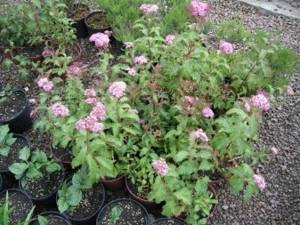
Before planting, the selected area must be thoroughly dug up and cleared of foreign debris. Planting holes must be slightly larger than the root system of seedlings. To prevent horses from rotting, experts recommend placing expanded clay, small pebbles or broken bricks at the bottom of the planting hole. Before removing seedlings from the container, the soil in it must be spilled with water. When removing a flower from a container, you should try to preserve the earthen lump as much as possible. All voids in the hole during planting must be filled with nutritious soil while simultaneously compacting it. It is strictly forbidden to deepen the root collar; its optimal location is at ground level. After planting, all surface greenery must be cut off and the hole should be watered generously with clean, settled water.
How to properly care?
Due to the fact that spirea “Crispa” is an unpretentious plant, caring for it will not cause difficulties even for novice gardeners. Under favorable climatic conditions, this flower practically does not need additional watering, but in very dry periods it is still necessary to moisten the soil. The optimal amount for one bush is 10 liters. The entire root zone must be covered with peat or crushed tree bark.
Like all plants, spirea needs regular feeding . In the spring, it is advisable to enrich the soil with nitrogen; in the summer, flowers need potassium and phosphorus, but in the fall, superphosphate must be added. Experienced summer residents recommend purchasing a special mineral complex, a one-time application of which will provide the flower with all the necessary microelements for the whole year.
Particular attention should be paid to pruning spirea, which comes in the following types:
- sanitary;
- stimulating;
- formative;
- rejuvenating.
Regular sanitary pruning, during which it is necessary to remove all dry shoots and inflorescences, as well as deformed branches, will help give the bush a beautiful and attractive appearance.
It is advisable to carry out the first stimulating pruning 3 years after planting.
This manipulation is aimed at increasing the thickness and density of the crown. The technology of the procedure is to reduce the length of old shoots in early spring to 25 cm. Carrying out spring stimulating pruning will allow you to get the first flowers in early June. If you ignore the procedure, the plant will be able to bloom only in July. Removing faded inflorescences at the beginning of autumn will provoke re-blooming of the bush in the middle of this season under favorable climatic conditions.

